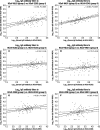Prevalence of antibodies to four human coronaviruses is lower in nasal secretions than in serum
- PMID: 20943876
- PMCID: PMC3008199
- DOI: 10.1128/CVI.00278-10
Prevalence of antibodies to four human coronaviruses is lower in nasal secretions than in serum
Abstract
Little is known about the prevalence of mucosal antibodies induced by infection with human coronaviruses (HCoV), including HCoV-229E and -OC43 and recently described strains (HCoV-NL63 and -HKU1). By enzyme-linked immunosorbent assay, we measured anti-HCoV IgG antibodies in serum and IgA antibodies in nasal wash specimens collected at seven U.S. sites from 105 adults aged 50 years and older (mean age, 67 ± 9 years) with chronic obstructive pulmonary disease. Most patients (95 [90%]) had at least one more chronic disease. More patients had serum antibody to each HCoV strain (104 [99%] had antibody to HCoV-229E, 105 [100%] had antibody to HCoV-OC43, 103 [98%] had antibody to HCoV-NL63, and 96 [91%] had antibody to HCoV-HKU1) than had antibody to each HCoV strain in nasal wash specimens (12 [11%] had antibody to HCoV-229E, 22 [22%] had antibody to HCoV-OC43, 8 [8%] had antibody to HCoV-NL63, and 31 [31%] had antibody to HCoV-HKU1), respectively (P < 0.0001). The proportions of subjects with IgA antibodies in nasal wash specimens and the geometric mean IgA antibody titers were statistically higher for HCoV-OC43 and -HKU1 than for HCoV-229E and -NL63. A higher proportion of patients with heart disease than not had IgA antibodies to HCoV-NL63 (6 [16%] versus 2 [3%]; P = 0.014). Correlations were highest for serum antibody titers between group I strains (HCoV-229E and -NL63 [r = 0.443; P < 0.0001]) and between group II strains (HCoV-OC43 and -HKU1 [r = 0.603; P < 0.0001]) and not statistically significant between HCoV-NL63 and -OC43 and between HCoV-NL63 and -HKU1. Patients likely had experienced infections with more than one HCoV strain, and IgG antibodies to these HCoV strains in serum were more likely to be detected than IgA antibodies to these HCoV strains in nasal wash specimens.
Figures

References
-
- Braunwald, E. 2005. Normal and abnormal myocardial function, p. 1358. In D. L. Kasper, A. S. Fauci, D. L. Longo, E. Braunwald, S. L. Hauser, and J. L. Jameson (ed.), Harrison's principles of internal medicine, 16th ed. McGraw-Hill Medical Publishing Division, New York, NY.
Publication types
MeSH terms
Substances
Grants and funding
LinkOut - more resources
Full Text Sources
Other Literature Sources
Miscellaneous

